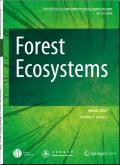Optimizing competitor definitions for the sustainable management of dominant silver fir trees (Abies alba Mill.) in uneven-aged mixed Dinaric forests
IF 4.4
1区 农林科学
Q1 FORESTRY
引用次数: 0
Abstract
Understanding competition between trees is essential for sustainable forest management as interactions between trees in uneven-aged mixed forests play a key role in growth dynamics. This study investigated nine competition indices (CIs) for their suitability to model the effects of neighboring trees on silver fir (Abies alba) growth in Dinaric silver fir-European beech (Fagus sylvatica) forests. Although numerous competition indices have been developed, there is still limited consensus on their applicability in different forest types, especially in mature, structurally complex forest stands. The indices were evaluated using the adjusted coefficient of determination in a linear model wherein the volume growth of the last five years for 60 dominant silver fir trees was modeled as a function of tree volume and competition index. The results demonstrated that distance-dependent indices (e.g., the Hegyi height-distance competition and Rouvinen-Kuuluvainen diameter-distance competition indices), which consider the distance to competitors and their size, perform better than distance-independent indices. Using the optimization procedure in calculating the competition indices, only neighboring trees at a distance of up to 26-fold the diameter at breast height (DBH) of the selected tree (optimal search radius) and with a DBH of at least 20% of that of the target tree (optimal DBH) were considered competitors. Therefore, competition significantly influences the growth of dominant silver firs even in older age classes. The model based solely on tree volume explained 32.5% of the variability in volume growth, while the model that accounted for competition explained 64%. Optimizing the optimal search radius had a greater impact on model performance than optimizing the DBH threshold. This emphasizes the importance of balancing stand density and competition in silvicultural practice.
在不均匀树龄的迪纳尔混交林中,为优势银杉的可持续管理优化竞争者定义
了解树木之间的竞争对可持续森林管理至关重要,因为在年龄不均匀的混交林中,树木之间的相互作用在生长动态中起着关键作用。研究了9个竞争指数(CIs)对Dinaric银冷杉-欧洲山毛榉(Fagus sylvatica)森林中邻近树木对银冷杉(Abies alba)生长影响的适用性。虽然已经开发了许多竞争指数,但它们在不同森林类型,特别是在成熟的、结构复杂的林分中的适用性仍然有限的共识。利用线性模型中调整的决定系数对这些指标进行评估,其中60棵优势银杉树近5年的体积增长作为树木体积和竞争指数的函数建模。结果表明,考虑竞争对手距离和规模的距离依赖指数(如Hegyi高度-距离竞争指数和Rouvinen-Kuuluvainen直径-距离竞争指数)优于距离独立指数。利用优化程序计算竞争指标时,只有距离所选树胸径(DBH)不超过26倍(最优搜索半径)且DBH至少为目标树胸径(最优DBH)的20%的邻近树才被视为竞争对手。因此,竞争显著影响优势银杉的生长,即使在年龄较大的班级。仅基于树木体积的模型解释了32.5%的体积增长变异,而考虑竞争的模型解释了64%。优化最优搜索半径对模型性能的影响大于优化DBH阈值。这强调了在造林实践中平衡林分密度和竞争的重要性。
本文章由计算机程序翻译,如有差异,请以英文原文为准。
求助全文
约1分钟内获得全文
求助全文
来源期刊

Forest Ecosystems
Environmental Science-Nature and Landscape Conservation
CiteScore
7.10
自引率
4.90%
发文量
1115
审稿时长
22 days
期刊介绍:
Forest Ecosystems is an open access, peer-reviewed journal publishing scientific communications from any discipline that can provide interesting contributions about the structure and dynamics of "natural" and "domesticated" forest ecosystems, and their services to people. The journal welcomes innovative science as well as application oriented work that will enhance understanding of woody plant communities. Very specific studies are welcome if they are part of a thematic series that provides some holistic perspective that is of general interest.
 求助内容:
求助内容: 应助结果提醒方式:
应助结果提醒方式:


